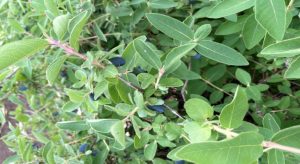The Honeyberry: The Blueberry Alternative
University of Illinois Extension Services — June 2, 2021Tasting the first local fruit before Memorial Day weekend was not something I expected to be able to do in Northern Illinois. Especially as we have had colder May temperatures and are in the middle of an abnormally dry period with a need for rain. Yet seeing the small blue fruits ready to be picked, I knew it was Honeyberry season.
Honeyberry (Lonicera caerulea) is a cultivated edible member in the honeysuckle family. With shrub like growth and flavor similar to blueberries, it thrives in our planting zone and even colder climates. Haskaps are another term that you might see for Honeyberry. Each spring, cream colored flowers appear hidden under the leaves of the honeyberry plant. Soon after pollination, a droplet shaped, blue-purple fruit begins to develop. The flavor is tart but I find that it isn’t anywhere near the tartness of fruits like Aronia or Goji. Like those berries, honeyberry has high antioxidants. Fruits tend to be in clusters of 4-5 each. The harvest period lasts for usually a good month.
Our Winnebago County Extension office has been fortunate to have a selection of these plants since 2015 thanks to an Illinois Specialty Crops Block Grant. The main purpose of this grant was to determine the crops suitability for backyard and commercial production. We’ve been pleased so far with their growth, flavor, and other characteristics. As with any “newer/trendy” fruits, we still have more to learn about them. Goji was planted in this trial and we were not pleased with the plant’s growth characteristics. While it grows well, it is covered in thorns and has an invasive quality to it.
I find many parallels between honeyberry and blueberry. Plants are similar in shape and size though honeyberry can be taller. Flavor of the berries is similar. The main difference is that honeyberry does not have the soil pH requirement that blueberry does. If you have tried to grow blueberries, you know that they need very acidic soils (4.5-4.8) and reaching and maintaining that pH level can be very hard. With honeyberry, you could get a fruit similar in taste without needing to address that soil pH.
From a northern Illinois grower’s perspective, honeyberry could compliment spring vegetables like asparagus/rhubarb and be available for sale before strawberry season. The plants are a good height to allow pick-your-own and are without thorns. They do not develop canes like raspberries or blackberries.
Honeyberry’s ability to thrive in our planting zone is further consideration. Because of this early harvest, the fruits may miss any damage from Spotted Wing Drosophilia too. Some of the challenges are that harvest is done by hand and educating consumers about Honeyberry may take time.
Honeyberries are not without their own growing needs. Pruning must be done every 2-3 years to keep these plants in shape and yielding well for you. Birds can be a problem for these berries, and you may find that you need netting or need to place them in the right area. You must plant more than one variety to ensure proper cross-pollination occurs. If interested in growing honeyberry, there are many different varieties available from reputable nurseries. We always recommend getting a soil test before planting.
Honeyberries can be used as a replacement in many berry recipes you might have. The tartness does require a sweetener in most cases. From the first harvest, I made a Honeyberry cobbler with plans for a sorbet this Memorial Day weekend.
By Grant McCarty, Extension educator, Local Food Systems and Small Farms, serving Jo Daviess, Stephenson and Winnebago counties, and Bruce Black, horticulture educator, serving Carroll, Lee and Whiteside counties








